| Norway
at a Glance - Quick Facts and Figures | 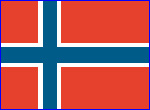 - Official
Name: Kingdom of Norway
- Population:
4,551,000
- Capital City: Oslo (791,500)
-
Latitude/Longitude: 62° 00'N, 10° 00'E
-
Language: Norwegian
- Official Currency:
Norwegian Krone
1 US Dollar = 6.78344 Norwegian Kroner (NOK) (on 2/18/06) -
Religions: Evangelical Lutheran, others
-
Land Area: 306,830 sq. km (118,467 sq. miles)
-
Landforms: Norway is a rugged land of ice age glaciers, mountains, plateaus and
deep, forested valleys.
- The coastline
(1,500 miles long) is deeply indented by fjords, and includes (over 45,000) scattered
islands. The Lofotens are the largest island group.
-
In the far north, frozen arctic tundra dominates the landscape. The Kjolen Mountains
form part of its northern border with Sweden, while the Jotunheimen Range covers
the south-central. Galdhopiggen is the highest point, at 8,100 ft. (2,469m). The
Jostedalsbreen icefield (glacier) sits just to the west of Galdhopiggen.
-
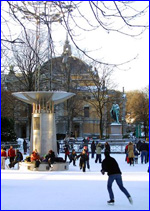 Dozens
of long, irregular fjords cover the western coast, largest include the Hardanger,
Oslo and Trondheim. Dozens
of long, irregular fjords cover the western coast, largest include the Hardanger,
Oslo and Trondheim. - The south central
plateau (the Hardangervidda), slopes into the Trondelag, a lowland (hilly) farming
area. Additional lowlands are found in the southeast, and along parts of the southern
coastline.
- There are over 150,000
lakes, most quite small, with the largest being Lake Mjosa. Significant rivers
include the Glama (Glomma) (the country's longest), and the Dramselva, Lagen and
Tana.
- Land Divisions: 19 provinces,
including: Akershus, Aust-Agder, Buskerud, Finnmark, Hedmark, Hordaland, More
og Romsdal, Nordland, Nord-Trondelag, Oppland, Oslo, Ostfold, Rogaland, Sogn og
Fjordane, Sor-Trondelag, Telemark, Troms, Vest-Agder, and Vestfold , Vest-Agder,
and Vestfol
- http://www.visitoslo.com
- http://www.norway.com
|
|
|
|
|
|
|
 Asker
is a suburb 20 kilometers west of Oslo - the capital of Norway. Here you will
find most of the scenery that the rest of the country has to offer you. The different
parts of the municipality are shielded from the north and open to the sea and
sun to the south. Asker has it all; a fjord with exciting Islands with small communities
on some of the Islands, open, wide and lush valleys, cultivated land, hilly terrain,
challenging rock faces and deep forests. In other words, a place to seek serenity,
but also urban action! Asker
is a suburb 20 kilometers west of Oslo - the capital of Norway. Here you will
find most of the scenery that the rest of the country has to offer you. The different
parts of the municipality are shielded from the north and open to the sea and
sun to the south. Asker has it all; a fjord with exciting Islands with small communities
on some of the Islands, open, wide and lush valleys, cultivated land, hilly terrain,
challenging rock faces and deep forests. In other words, a place to seek serenity,
but also urban action!
More than 50,000 people lives in Asker. It's a heavily
populated area considering the fact that more than half the area is cultivated
land and productive forestry. Business here is mostly in technology, shipping,
trade in goods and commercial services.
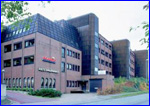 In
the center of Asker you will find the new Asker Kulturhus that was finished in
November 2005. This beautiful new facility contains two Concert Halls, a Movie
Center and Library. In
the center of Asker you will find the new Asker Kulturhus that was finished in
November 2005. This beautiful new facility contains two Concert Halls, a Movie
Center and Library.
In walking distance from the Kulturhus you will find
the Scandic Hotel Asker, where all the CIA Executive and Music Committee Members,
Delegates, Judges and Candidates will stay.
Asker is the last station
on the Airport train from Gardermoen Aiport (main airport in Oslo) located in
the northern part of Oslo. If you are going to Torp Airport in the southern part
of Oslo, you can take the convenient bus service to Asker.
|
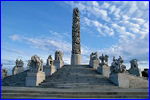 From
800-1050 AD, the Norsemen entered the European arena in a serious way. They came
suddenly and intensely and frightened the daylights out of established society,
which certainly was used to war, but not to the surprise tactics employed by the
Vikings. From
800-1050 AD, the Norsemen entered the European arena in a serious way. They came
suddenly and intensely and frightened the daylights out of established society,
which certainly was used to war, but not to the surprise tactics employed by the
Vikings.
Historical Milestones: - 9000
BC - 8000 BC:Earliest signs of human settlement.
- 8000
- 4000 BC: Old Stone Age, hunters and fishermen, rock carvings.
- 4000
BC - 1500 BC: New Stone Age, early agriculture, livestock.
- 1500
BC - 500 BC: Bronze Age, agricultural tools, jewelry, glass, weapons.
- 500
BC - 800 AD: Iron Age, iron ploughs and scythes.
- 800
AD - 1050 AD: Viking Age, longships, trade and conquest, runic inscriptions, voyages
of discovery, Leif Eiriksson discovers America.
- 900
AD: Norway united into one kingdom.
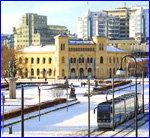 1030:
Christianity adopted in Norway. 1030:
Christianity adopted in Norway.
- 1130:
Start of High Middle Ages, population growth, and consolidation of power both
of church and crown.
- 1100 - 1200:
Monarchy controls the church, slavery abolished.
- 1350:
The Black Death reduces the population by almost two-thirds.
- 1380
- 1536: Union with Denmark through royal intermarriage.
- 1536:
Norway ceases to be an independent kingdom.
- 1814:
The Norwegian Constitution adopted, based on the American Declaration of Independence.
- 1814
- 1905: Union with Sweden.
- 1905: End
of Union. Haakon VII crowned king.
- 1913:
Universal right to vote for women: Norway is among the first in the world to grant
suffrage.
- 1940 - 1945: World War II,
Norway occupied by Germany.
- 1957:
Death of Haakon VII - Olav V crowned king.
- 1970:
Oil and gas deposits discovered off the Norwegian coast.
- 1981:
Norway's first female Prime Minister.
- 1991:
Death of Olav V, Harald V becomes king.
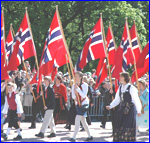 May
17th - Syttende Mai May
17th - Syttende Mai
The national day of celebration in Norway, May
17th is Norway's Constitution Day. It was on this day in 1814 that Norway's constitution
was signed by the national assembly at Eidsvoll, making Norway a free and independent
nation. After having been a part of the Danish autocracy for 400 years, Norway
now joined into a loose union with Sweden that lasted until 1905. A limited and
hereditary monarchy was introduced, whereby the king would exercise his authority
through a government, while Parliament (Storting) would allocate monies and make
laws. The Norwegian constitution was the most modern in Europe at the time. Norwegians
celebrate their national day differently than in any other country.
On
May 17th, it is the colorful processions of children with their banners, flags
and bands - not military parades - that play the main role. It is the spring celebration,
from the lowliest backwater to the capital city, where the royal family waves
to the passing procession from the palace balcony. Another special characteristic
that contributes to making this a unique day is all the beautiful bunads or national
costumes that more and more people are wearing in recent years. Foreigners especially
seem to delight in experiencing this special occasion.
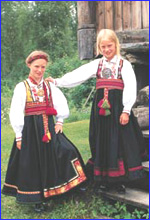 Bunads
- national costumes Bunads
- national costumes
The Norwegian bunad came into existence about 100
years ago when a wave of national romanticism swept across the country. Their
design is based on regional folk costumes that were on the verge of disappearing.
All of a sudden people wanted to preserve everything that was old and traditional
including the old costumes. Rural peasant customs were valued as that which was
genuinely Norwegian, and it was these rural areas that had the strongest folk
costume traditions.
People in the cities had long been influenced by foreign
fashion trends. The first bunads were clearly related to the most familiar folk
costumes. Where knowledge of old traditions was uncertain, inspiration was drawn
from separate parts of costumes or from other regional elements like rose painting,
wood carving or embroidery. In recent years, interest in Norwegian bunads and
folk costumes has steadily been increasing. This is especially apparent on May
17th, when there is an incredible show of gorgeous costumes from all over the
country.
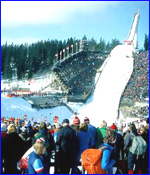 The
Cradle of Ski Sport The
Cradle of Ski Sport
In Norway, skis have been necessary because of
geographical and weather conditions. A rock carving from North Norway called «the
Rødøy Man» is assumed to depict a Norwegian skiing already
4000 years ago. Norse mythology speaks of skiing and hunting in the heroic poems.
Telemark is considered «the cradle of ski sport» because Sondre Nordheim
from Morgedal revolutionised skiing and rekindled interest in the sport in the
1870 -1880's. He began using stiff bindings around the heel so that the skier
could turn and jump without losing his skies. The «Telemark» ski he
constructed was narrower at the middle and became the prototype for all later
ski production. Morgedal was as such a natural place for the Olympic flame to
be lit before the Lillehammer Olympics in 1994.
After crossing Greenlands's
inland frozen wasteland from east to west, Fridtjof Nansen wrote that «skiing
is the most national of all Norwegian sports, and what a fantastic sport it is
too. If any sport deserves to be called the sport of all sports, it is surely
this one». Today, skiing is the No. 1 winter sport for Norwegians, and throughout
the entire country there are excellent opportunities to pursue this sport.
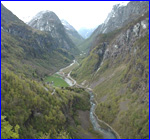 The
Pilgrims Way to Trondheim The
Pilgrims Way to Trondheim
Trondheim, or Nidaros, was Norway's first
capital. Sagas tell that Olav Tryggvason founded the town by the mouth of the
river Nidelva in 997 AD. Archeologists have however proven that there were settlements
here long before then. The sainted King Olav Haraldsson was buried here in 1030.
Nidaros Cathedral was erected over his grave, and for four centuries this city
was a pilgrimage site for pilgrims seeking consolation, help and healing. The
old pilgrimage way to Trondheim and to Nidaros Cathedral was reopened the summer
of 1997. Since then many pilgrims have wandered to this ancient pilgrimage site.
From
1153 to 1537, Trondheim was the seat of the country's archbishop and the spiritual
center of an area including Greenland, the Faroe Islands, the Orkney Islands and
the Isle of Man. Today, Trondheim is a modern city that is a major center of learning
and one of the best research environments in Europe.
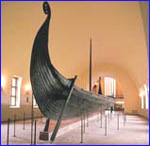 The
Vikings The
Vikings
From 800-1050 AD, the Norsemen entered the European arena in
a serious way. They came suddenly and intensely and frightened the daylights out
of established society, which certainly was used to war, but not to the surprise
tactics employed by the Vikings. The Vikings were not just warriors and seafarers.
They were also peaceful farmers and merchants. They came from what today are Denmark,
Sweden and Norway. In Oslo, there are wonderful opportunities to become familiar
with the Vikings and their age, especially their seaworthy sailing vessels. Several
of these beautiful long ships can be seen at the Viking ship museum and in the
theme park Vikinglandet it is possible to get a good impression of how life may
have been in a Viking village of that time.
|

 Asker
is a suburb 20 kilometers west of Oslo - the capital of Norway. Here you will
find most of the scenery that the rest of the country has to offer you. The different
parts of the municipality are shielded from the north and open to the sea and
sun to the south. Asker has it all; a fjord with exciting Islands with small communities
on some of the Islands, open, wide and lush valleys, cultivated land, hilly terrain,
challenging rock faces and deep forests. In other words, a place to seek serenity,
but also urban action!
Asker
is a suburb 20 kilometers west of Oslo - the capital of Norway. Here you will
find most of the scenery that the rest of the country has to offer you. The different
parts of the municipality are shielded from the north and open to the sea and
sun to the south. Asker has it all; a fjord with exciting Islands with small communities
on some of the Islands, open, wide and lush valleys, cultivated land, hilly terrain,
challenging rock faces and deep forests. In other words, a place to seek serenity,
but also urban action! In
the center of Asker you will find the new Asker Kulturhus that was finished in
November 2005. This beautiful new facility contains two Concert Halls, a Movie
Center and Library.
In
the center of Asker you will find the new Asker Kulturhus that was finished in
November 2005. This beautiful new facility contains two Concert Halls, a Movie
Center and Library.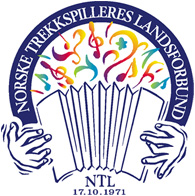

 Dozens
of long, irregular fjords cover the western coast, largest include the Hardanger,
Oslo and Trondheim.
Dozens
of long, irregular fjords cover the western coast, largest include the Hardanger,
Oslo and Trondheim.  From
800-1050 AD, the Norsemen entered the European arena in a serious way. They came
suddenly and intensely and frightened the daylights out of established society,
which certainly was used to war, but not to the surprise tactics employed by the
Vikings.
From
800-1050 AD, the Norsemen entered the European arena in a serious way. They came
suddenly and intensely and frightened the daylights out of established society,
which certainly was used to war, but not to the surprise tactics employed by the
Vikings.  1030:
Christianity adopted in Norway.
1030:
Christianity adopted in Norway. May
17th - Syttende Mai
May
17th - Syttende Mai Bunads
- national costumes
Bunads
- national costumes The
Cradle of Ski Sport
The
Cradle of Ski Sport The
Pilgrims Way to Trondheim
The
Pilgrims Way to Trondheim The
Vikings
The
Vikings